S.Q. Eries's Blog, page 40
April 12, 2016
Manga Review: Master Keaton Vol. 5
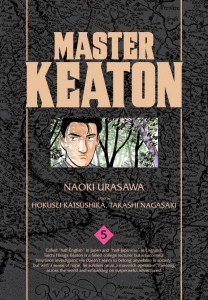 I became an instant fan of Naoki Urasawa in 2004 when I saw the Monster anime. Psychological thrillers are NOT my cup of tea, but he had me hooked with his combination of realistic artwork and gripping plot. As such, I was thrilled when Viz Media decided to release a translation of an earlier Urasawa action/adventure: Master Keaton. Read on for the review of Volume 5! (For my review of previous volumes, click here.)
I became an instant fan of Naoki Urasawa in 2004 when I saw the Monster anime. Psychological thrillers are NOT my cup of tea, but he had me hooked with his combination of realistic artwork and gripping plot. As such, I was thrilled when Viz Media decided to release a translation of an earlier Urasawa action/adventure: Master Keaton. Read on for the review of Volume 5! (For my review of previous volumes, click here.)
Back Cover Blurb
Called “half English” in Japan and “half Japanese” in England, Mr. Keaton is a failed college lecturer but a successful insurance investigator… He doesn’t seem to belong in any society, but with a sense of hope, he soldiers on as a maverick operative, traveling across the world and embarking on suspenseful adventures!
The Review
Most stories in this series have been one to two chapters in length, but “The Leopard’s Cage” arc consists of five chapters. That makes it the longest of the Master Keaton tales thus far, but by no means does it drag. The opener with its BBC broadcast to British operatives is a bit silly, but after that, it’s a thrilling ride. The setting is Iraq right after its invasion of Kuwait. Iraq has taken British citizens hostage, and the British government sends Keaton in after Richard, an old classmate who happens to be a member of the royal family. Also part of the operation is Nasr, a Pakistani-British agent, who has his own set of unique skills. In addition to the difficulties of moving in enemy territory, Richard is a severe diabetic with a limited amount of insulin, and he’s also incurred the wrath of an Iraqi Major General known as the Eagle of Karun. This tank-toting general is probably Keaton’s most difficult adversary yet. Keaton’s and Nasr’s skills combined are only barely able to keep them ahead of the Eagle of Karun. The story is also interesting in that it’s a look back to an old regime in an area that continues to be plagued with unrest.
Keaton also gets involved in SAS business in the two-part “David Bobbid” arc. Whereas “The Leopard’s Cage” deals with a present war, this arc deals with a past military conflict and pits Keaton against SAS officers gone bad. The David Bobbid character is kind of freaky, especially his appearance, but the story does drive home how combat trauma manifests in various ways.
The remaining stories are short insurance cases and a flashback into Keaton’s childhood. We have the usual token appearances by Keaton’s father and daughter, but they stay mostly in the backdrop in this installment.
Extras include the first pages of Chapter 1 in color and a sound effects glossary.
In Summary
Keaton gets sucked back to his SAS life for much of this volume. Interestingly, the five-chapter spy adventure of “The Leopard’s Cage” has Keaton using equal parts of his archaeology knowledge and military training, something we haven’t seen in a while. The SAS stories also provide commentary on relatively recent military conflicts. The remaining tales in this installment aren’t nearly as strong, but “The Leopard’s Cage” definitely makes Volume 5 worth your while.
First published at the Fandom Post.


April 5, 2016
Light Novel Review: Spice and Wolf Vol. #16
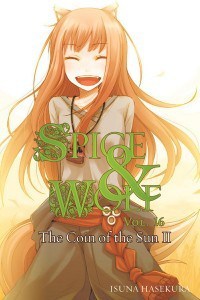 Spice and Wolf is a wildly popular light novel series that has spawned off an anime, an Internet radio show, and a manga series. While its European medieval setting is typical of high fantasy, this series has a unique bent. Rather than swordfights and magic, the plot focuses on economics, trade, and peddling in a way that skillfully blends adventure and romance.
Spice and Wolf is a wildly popular light novel series that has spawned off an anime, an Internet radio show, and a manga series. While its European medieval setting is typical of high fantasy, this series has a unique bent. Rather than swordfights and magic, the plot focuses on economics, trade, and peddling in a way that skillfully blends adventure and romance.
Yen Press has released Volume 16 of this series, and you can read on for the review. (You can also click here for my reviews of previous Spice and Wolf releases).
Back Cover Blurb
The introduction of a new currency in the town of Lesko has filled Lawrence with boundless optimism, but his dreams come to a sudden and harsh end when two men from the Debau Company present him with a grim token-Col’s traveling bag. With his young friend’s safety threatened and the stability of the town suddenly in doubt, Lawrence’s plans to open a shop are dashed. Separated from Holo yet again, he finds himself a forced participant in a desperate scheme to reclaim the Debau Company from the nobility who now control it. But when mercenary armies clash in the mountains, what will become of Lawrence and Holo? For good or ill, the finale of their tale is at hand!
The Review
After the cliffhanger of Volume 15, I was eager for the conclusion to the Coin of the Sun. With the return of so many characters from the early part of the series, I was certain Volume 16 would begin with yet another reunion. Instead, Hasekura-sensei throws readers for a loop with the introduction of Hilde Schnau. He provides not only a look into the inner workings of the Debau Company, which Lawrence could only guess at earlier, but the efforts of the ancient to shape the new age.
Since arriving in the Northlands, Holo and Laurence have only encountered one being like Holo, the art dealer Hughes. However, it stands to reason that there would be more. After all, the Northlands are the last bastion of the pagan world. Unlike Hughes, who is content to drift along in the tide of mankind, some are actively working to control that flow, and Holo and Lawrence encounter not one, but three of these beings.
Thanks to internal strife within the Debau Company and Schnau’s plotting, the forbidden book once again becomes key to the fate of the Northlands. In addition, the mercenary companies that had been idle in Lesko finally see some action. The world of Spice and Wolf has been seen largely through the filter of trade; men of war are viewed as opportunity for profit or the hand that enforces the rules by which merchants play. However, Lawrence now gets a glimpse into the world of mercenaries and the rules they abide by. Thus, this fantasy gets some swordplay along with a healthy dose of backstabbing and betrayal.
Not surprisingly, Lawrence is practically useless on the battlefield. And when it comes to dealings on the scale of the Debau Company, he can only marvel at the power and skill wielded by its top strategists. However, there are things only a traveling merchant can observe, and Lawrence gets to make his own dramatic revelation. His thought process is somewhat more agonized than when he worked out the money order scheme with Delink, but it is fortunately much easier to comprehend than the backroom dealings in Kerube.
In the midst of all this excitement, we have Holo and Lawrence striving to forge a path to a quiet future together. This is a change in the dynamic where Holo is always keeping Lawrence at arm’s length. After they join hands in Volume 15, circumstances seem to be conspiring to pull them apart. In fact, Lawrence spends Chapter 7 and most of Chapter 8 away from Holo. However, absence makes the heart fonder, and readers will get to see a display of affection hitherto unthinkable for our wisewolf. No, there’s no steamy smut, but it is sweet, albeit with a dash of Holo’s trademark bite.
This light novel includes the first four pages of illustrations printed in color, world map, and eight black-and-white illustrations.
In Summary
Merchant and wolf reach their journey’s end, and it’s a brilliant finale with unexpected new characters, swordplay, underhanded schemes, and, of course, romance. Lawrence has been called “fool” countless times throughout this series, and over the last several volumes, the threat of ruin has hung over the Northlands. However, Lawrence has grown through his misadventures, and it’s beautiful to see his insight combine with Holo’s strength to protect her ancient homeland.
First published at the Fandom Post.


March 29, 2016
Manga Review: Barakamon Vol. 8
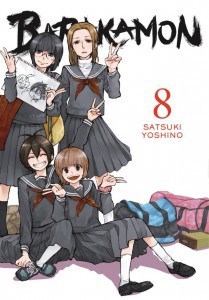 The contrast between city and rural life has been a source of entertainment since the time of Aesop’s fables. It remains a popular subject in manga and anime today, and joining the ranks of Silver Nina, Non Non Biyori, and Silver Spoon is Yen Press’ series Barakamon. Read on for my review of Volume 8! (For my reviews of previous volumes, click here.)
The contrast between city and rural life has been a source of entertainment since the time of Aesop’s fables. It remains a popular subject in manga and anime today, and joining the ranks of Silver Nina, Non Non Biyori, and Silver Spoon is Yen Press’ series Barakamon. Read on for my review of Volume 8! (For my reviews of previous volumes, click here.)
Back cover blurb
Miwa and Tama leave the island on their middle-school class trip! While the girls are away, handsome young calligrapher Seishuu Handa attempts his first island broadcast, helps Kuroshi (formerly Hiroshi) prepare for an interview, and completely neglects his calligraphy! And in the middle of all this bustle comes the sudden appearance of an ambulance?! The eighth volume of this heartwarming island comedy is full of bittersweet persimmons, souvenirs, and good-byes!
The Review
“I’m being utterly contaminated by the island!!” is what the back cover screams, and that does appear to be the case for Handa. After four months, he and the islanders have grown accustomed to one another, which means less opportunity for “clueless city boy” themed humor. As such, Yoshino-sensei continues using alternate characters as the butt of jokes, and in Volume 8, that role gets mostly saddled onto Miwa and Tama.
While it’s nice to see these two troublemakers suffer for a change, the situations are hardly original. Their cake baking disaster is a scenario done to death, and Miwa gets tiresome as the annoying classmate on the middle school trip gone wrong. The giving of their pathetic souvenirs isn’t much better. Fortunately, Hiroshi’s unsettled career path continues to provide laughs and an opportunity for Handa to play the immature adult.
Then there’s a sudden shift in mood with the passing of the elderly islander Kiyoba. Handa gets roped in to help with the funeral, and the fact that his neighbors are relying on his help is another indication of how he’s become a part of the community. Even so, he’s greatly unfamiliar with their rituals, and readers learn along with him how this village pays its last respects. It’s similar in many respects to the Obon Festival arc, where Handa goes in with certain preconceptions that end up shattered. Like most things on the island, the funeral isn’t a gloomy affair so laughter and yelling coexist amid the more touching moments as Kiyoba gets her final send off.
Extras include a bonus one-page manga, translation notes, and another installment of “Barakamon News.”
In Summary
There’s not much calligraphy but lots of immature goofing around in this installment. Middle school antics dominate the first half with Miwa, Tama, and their class trip to Nagasaki. Unfortunately, most of their situation comedy is so unoriginal it gets tiresome quick. However, the second half becomes much more engaging when Handa helps the village pay final respects to one of its oldest members.
First published at The Fandom Post.


March 22, 2016
Manga Review: A Bride’s Story Vol. 7
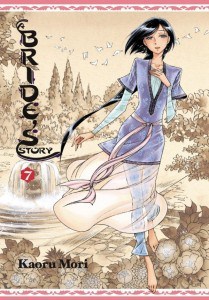 Kaoru Mori is best known for her work, Emma, an exquisite romance/slice-of-life set in Victorian England. Her latest work to be released in the United States, A Bride’s Story, is also a historical/slice-of-life but is vastly different than Emma. Set in Central Asia in a rural town near the Caspian Sea during the early 19th century, A Bride’s Story revolves around a young woman, Amir, who arrives from a distant village across the mountains to marry Karluk, a boy 8 years her junior. Volume 7 has been released, and you can read on for the review. (For reviews of other volumes, click here.)
Kaoru Mori is best known for her work, Emma, an exquisite romance/slice-of-life set in Victorian England. Her latest work to be released in the United States, A Bride’s Story, is also a historical/slice-of-life but is vastly different than Emma. Set in Central Asia in a rural town near the Caspian Sea during the early 19th century, A Bride’s Story revolves around a young woman, Amir, who arrives from a distant village across the mountains to marry Karluk, a boy 8 years her junior. Volume 7 has been released, and you can read on for the review. (For reviews of other volumes, click here.)
Back Cover Blurb
Acclaimed creator Kaoru Mori’s tale of life on the nineteenth-century Silk Road continues as Mr. Smith extends his journey. This time, he is welcomed into the home of a wealthy tradesman and his wife, Anis. Custom dictates that, as a woman, Anis is not permitted to meet their visitor face-to-face, but even so, she counts herself blessed to live in such a beautiful estate and be married to a man who devotes himself solely to her. Still, one cannot help but long for the companionship of another person when one’s closest friend is a reluctant Persian cat. In her loneliness, Anis visits the public bath house and discovers a place where she feels immediately free among her fellow sisters.
The Review
After the fighting, backstabbing, and chaos of Volume 6, Mori-sensei switches gears. We rejoin Mr. Smith as he enters a new town, where he becomes the guest of a wealthy tradesman. Unlike the previous village where he was constantly interacting with the twins and the other females in the community, the women in this area wear burkas and don’t show their faces to men outside their family. As such, Mr. Smith never actually gets to meet Anis, his host’s wife, who is the focus of this volume.
Anis is a stark contrast to those we’ve met so far. Her movements are limited, but hers is a carefree, privileged existence. She lives in an idyllic estate, loves her adoring husband, and has a healthy baby son. In her world, she’s the woman who has it all. Yet she’s extremely isolated (her main companion is a cat that looks an awful lot like the grumpy cat). Thus, we have a story about a woman seeking female friendship.
Mori-sensei uses Anis’ search to explore two lesser known aspects of Persian culture. The first is the public baths. Although the women in Anis’ community have to cover themselves completely outside their homes, they are not depicted as repressed or abused. Rather, their customs are inconvenient, but they have ways of dealing with it, one of which is the women’s bath. It’s not just a place to get clean. It’s where they relax, socialize, and enjoy themselves. When Smith first passes by the building, he thinks there’s a festival because of the merry racket within. While children and elderly are also patrons, most illustrations of the naked clientele have a sensual quality.
The second aspect is the khwahar khwandagi, the avowed sisters. As described in the manga, it’s a special covenant that binds two married women in a relationship similar to husband and wife. Anis’ encounter with Sherine in the public bath and the course she takes after the two become avowed sisters is somewhat simplistic. However, Anis is a rather simple character, thus the story’s “happily ever after” outcome suits her.
Extras include Mori-sensei’s manga style afterword and a foldout color illustration of the women’s bath. Also, Mori-sensei’s depictions of Anis’ estate are especially gorgeous.
In Summary
From Amir’s active, noisy world, we enter the life of a woman who knows only peace and seclusion. The tradesman’s wife Anis doesn’t have to worry about finances or tribal warfare; she just wants to find a friend. While the customs in Anis’ region are completely foreign to westerners, she is a sweet, likable character, and readers will easily relate to her desire for a peer who understands her.
First published at the Fandom Post.


March 15, 2016
Manga Review: Are You Alice? Vol. 10
 Lewis Carroll’s Alice in Wonderland has inspired all sorts of spinoff works, from visual art to movies to manga. However, Ai Ninomiya may have conjured up the most unusual Alice yet. Are You Alice?, which originally began as a CD series, features a gun-toting male as its Alice! Yen Press has released the tenth volume, and you can read on for the review. (If you’re interested in my reviews for previous volumes, click here.)
Lewis Carroll’s Alice in Wonderland has inspired all sorts of spinoff works, from visual art to movies to manga. However, Ai Ninomiya may have conjured up the most unusual Alice yet. Are You Alice?, which originally began as a CD series, features a gun-toting male as its Alice! Yen Press has released the tenth volume, and you can read on for the review. (If you’re interested in my reviews for previous volumes, click here.)
Back Cover Blurb
When Lewis Carroll took in a little black cat for Alice Liddell, he most likely never imagined that it would be the sole witness to his final throes of madness. Nor could he have fathomed just how much a cynical alley cat could make of his discarded characters. So spins the tale of how the Cheshire Cat came to be–and how he may yet come to be Lewis Carroll’s undoing.
The Review
The journey through this Wonderland has been a twisted–and often violent–dive through the rabbit hole. Now Volume 10 backtracks in time to show how that rabbit hole came to be, which is a twisted and violent tale in itself. And our guide though this particular story is the Cheshire Cat.
The Cheshire Cat has been a difficult character to comprehend, but so is everyone else. As such, I assumed he wasn’t anything special. Turns out he is special indeed. Unlike the other Wonderland residents, he is not bound by a rule nor did he receive his name from the White Rabbit. But what makes him truly unusual is that he actually knew the original Alice and Lewis Carroll.
The narrative begins well before the cat meets Alice. As it turns out, Alice is the cat’s third owner. Even so, his life’s beginning provides a pretty good look at the “real” world, where Alice in Wonderland was written. Judging by his series of owners, this place may not be Wonderland, but it has its own kind of crazy, So much so that it’s almost fitting when Carroll loses his sanity. Having the cat as narrator also allows a glimpse into Alice and Carroll’s relationship through the eyes of a third party who can neither interfere in the tragedy that unfolds nor say anything about it. And as graphic as the volume’s images are, one of the most disturbing parts is the unillustrated text, “The Correct Way to Kill off Alice.”
Once the setting shifts away from the “real” world, however, that cat is doing plenty. Turns out the 89th Alice owes the Cheshire Cat a great deal for his existence In addition, the more we learn about Wonderland, the more it takes on a Toy Story-ish kind of feel. Carroll created Wonderland, but, like the toys in Toy Story, the scraps of words he discarded take on a life of their own. The Cheshire Cat might not have been able to do much for Alice as an ordinary cat, but he’s doing plenty in Wonderland, manipulating bits of writing for her sake.
Extras include closing remarks from the creator (although the background illustration is extremely dark), the short bonus manga “Are You Mack?” and the title page and table of contents printed in color.
In Summary
The story delves into the past, in particular, the Cheshire’s Cat’s past in the world of the original Alice and Lewis Carroll. These chapters fill a lot of gaps, plus they unveil surprising information about where the 89th Alice came from. The ultimate fate of Wonderland remains to be seen, but you will come away with a better understanding of the Cheshire Cat’s part in this story of discards.
First published at the Fandom Post.


March 8, 2016
Manga Review: My Little Monster Vol. 10
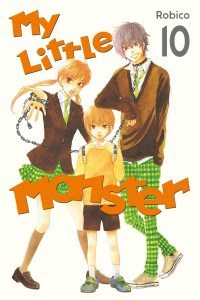 There’s the type of shojo manga where a girl really can envision herself as the heroine. And then there are those where the characters are constantly going off the deep end. My Little Monster falls into the latter category, and if your taste in high school romance leans toward the improbable and wacky, this title might be up your alley. Kodansha has released Volume 10 of the English translation, and you can read on for the review. (For my review of previous volumes, click here.)
There’s the type of shojo manga where a girl really can envision herself as the heroine. And then there are those where the characters are constantly going off the deep end. My Little Monster falls into the latter category, and if your taste in high school romance leans toward the improbable and wacky, this title might be up your alley. Kodansha has released Volume 10 of the English translation, and you can read on for the review. (For my review of previous volumes, click here.)
The Review
In previous volumes, we’ve had the opportunity to see things from Haru’s friends’ point of view. Now, in Volume 10, Haru’s brother gets a chance to narrate. Haru’s made clear that he hates his family, but Yuzan’s stance towards his brother is more complicated. Between Ando’s comment about Haru being “special” in the previous volume and Yuzan’s memories in Volume 10, Yuzan’s treatment of Haru makes much more sense even as Yuzan racks up sympathy points.
Their dad, on the other hand, earns negative points. Until now, we’ve only heard about him, and when we finally see him in person, he’s actually worse than his sons make him out to be. Yoshida Senior can be best described as the worst of womanizing politicians. He’s pretty flat as a character, and the best he is good for is shocking readers with whom he makes a pass on.
Thus, we get a clear picture of Yoshida family dynamics right before all three of them converge at the same event: Yuzan’s coming-of-age party. In addition to seeing the world in which the Yoshidas live, Shizuku gets her Cinderella moment. Every shojo manga with a poor, frumpy heroine and uber rich boy has an instant where she gets made over, and Shizuku gets her chance at Yuzan’s party. She actually cleans up really well (amazing what getting rid of pigtails will do) and so does Haru, for that matter.
The party draws an interesting mix of guests (I especially liked the reference to Shizuku’s mom). Shojo manga often turn this into the setting where mean girls embarrass the heroine. Nothing like that happens here, but the event does trigger a different kind of drama between Shizuku and Haru. As it turns out, Shizuku and Yuzan are more alike than anyone might guess, and I look forward to seeing how our heroine approaches their common dilemma.
Extras include bonus four-panel comics, short bonus manga about Yamaken’s past with the Yoshida brothers, and translation notes.
In Summary
Finally, a look at the Yoshida family’s glorious dysfunction. Flashbacks and a chapter from Yuzan’s perspective provide a comprehensive look at the brothers’ upbringing and the circumstances that brought about their constant fighting. Their father is just a garden-variety slimy politician, but Yuzan’s dealings with a “special” brother has surprising parallels with Shizuku’s relationship with Haru, which makes for a interesting read.
First published at the Fandom Post.


March 1, 2016
Manga Review: Yukarism Vol. 4
 Geishas are an icon of Japanese culture that, although their heyday is long post, continues to fascinate Westerners to this day. If you’ve wondered about the lives of these flowers of Japan’s bygone pleasure districts, you may want to consider Chika Shiomi’s historical/time slip manga, Yukarism. Read on for my review of Volume 4. (For my review of other volumes, click here.)
Geishas are an icon of Japanese culture that, although their heyday is long post, continues to fascinate Westerners to this day. If you’ve wondered about the lives of these flowers of Japan’s bygone pleasure districts, you may want to consider Chika Shiomi’s historical/time slip manga, Yukarism. Read on for my review of Volume 4. (For my review of other volumes, click here.)
Back cover Blurb
Seemingly afflicted by Yumurasaki’s fatal illness of the past, Yukari begins to get very sick in the present day… Meanwhile, Mahoro vows to kill Satomi before he can kill Yukari (as she believes he killed Yumurasaki in the past)! Are these three fated to repeat their tragic connection?
The Review
I was surprised to learn Volume 4 is the final installment of the series. I thought Shiomi-sensei would draw out to the overlapping of Yukari’s current and former self a bit longer. However, Volume 4 wraps everything up, explaining the circumstances surrounding Yumurasaki’s death and Yukari’s strong connection to his past self before concluding with a concise epilogue for our characters.
While the reason for the muddling of past and present makes sense, the manga does go a bit overboard when classmates and even random bystanders start seeing Yumurasaki and Mahoro as their former selves and in their former pleasure district settings. Also, Mahoro’s merger with Takamura’s consciousness is awfully abrupt. Up to now, Yukari was the one most aware of what was happening, recognizing who was who as he bounced from past to present. Mahoro, on the other hand, seemed least in control, especially when she faced off against Satomi in Yukari’s house in Volume 2. If anyone seemed possessed by an evil spirit, it was her, and it is a bit jarring to have her suddenly in control of the situation and Satomi/Kazuma playing the crazed maniac instead.
However, if these plot changes don’t faze you and you’re more interested in watching an Edo period tsundere give all for the woman he loves, Yumurasaki’s death scene won’t disappoint. In addition to the poignancy of the moment, Shiomi-sensei’s accompanying artwork is gorgeous. The final pages of the manga are also sweet. By the story’s end, the POV shifts from Yukari to Mahoro, with only Mahoro/Takamura aware of the events that transpired, but that makes the conclusion no less romantic.
Extras include cast of characters, story thus far summary, a bonus one-page manga, translation notes, and author bio.
In Summary
The emotions of the past invade the present! The enmity between Mahoro/Takamura and Satomi/Kazuma explode into a final confrontation that’s occasionally heavy on the melodrama, but the enduring connection between Yumurasaki and Takamura brilliantly tugs the heartstrings. Yukari’s forays to old Edo turned into a different journey through time than Volume 1 led me to anticipate, but this tale of three misunderstood souls hasn’t been a bad one, especially with Shiomi-sensei’s beautiful illustrations.
First published at The Fandom Post.


February 23, 2016
Light Novel Review: Spice and Wolf Vol. #15
 Spice and Wolf is a wildly popular light novel series that has spawned off an anime, an Internet radio show, and a manga series. While its European medieval setting is typical of high fantasy, this series has a unique bent. Rather than swordfights and magic, the plot focuses on economics, trade, and peddling in a way that skillfully blends adventure and romance.
Spice and Wolf is a wildly popular light novel series that has spawned off an anime, an Internet radio show, and a manga series. While its European medieval setting is typical of high fantasy, this series has a unique bent. Rather than swordfights and magic, the plot focuses on economics, trade, and peddling in a way that skillfully blends adventure and romance.
Yen Press has released Volume 15 of this series, and you can read on for the review. (You can also click here for my reviews of previous Spice and Wolf releases).
Back Cover Blurb
The Myuri mercenary band–a troop named for one of Holo’s old comrades. In order to find them, Lawrence and Holo make for Lesko, a town dominated by the copper-trading Debau Company. Rumors of the Debau Company’s schemes to both open more mines and seize control of the northern lands swirl, along with rumors that they’re concentrating military power in the town in preparation. But when Lawrence and Holo arrive in Lesko, they discover a surprisingly cheerful and peaceful place. What is really happening? Find out as the final act of Holo the Wisewolf and Lawrence the traveling merchant’s long journey draws close to its end!
The Review
The Coin of the Sun is the final arc in Lawrence and Holo’s journey, and Hasekura-sensei pulls out all the stops. As wonderful as this series is, some parts have dragged, others have been confusing, and some installments have been weak on the economic front. However, Volume 15, which is the first of two parts, comes up strong all around, from the emotional tension between Holo and Lawrence to the sea change about to hit the Northlands.
Hasekura-sensei has set us up for certain expectations, and he uses those expectations to take his readers by surprise. For instance, over the last few volumes, our travelers have been hearing rumors that paint the Debau Company as the worst of organizations, ready to war and ruin the Northlands. So Holo and Lawrence head to Lesko as if it’s a march into enemy territory. But instead of a military stronghold, they find an unwalled trading center. Then there’s the tantalizing thread of a mercenary company with Holo’s packmate’s name. I’d expected it to lead to one of two scenarios, but Hasekura sensei delivers a third outcome, which has a profound effect on Holo and offers Lawrence the opportunity to be her emotional support.
The blossoming of Lawrence and Holo’s relationship is the best part of this volume for me. Over the journey, Lawrence has matured and his affections for Holo grown. Holo, on the other hand, invariably teases or scolds the poor merchant. In this volume, however, the circumstances in Lesko make her unusually vulnerable, and all the emotional walls come crashing down. Given past Lawrence’s frustrations with his companion (especially the recent slap in Lenos), this new level of intimacy between the two made my heart skip a beat, and Holo/Lawrence fans will be thrilled to see the two dreaming of a future together.
That dream, however, is not mere fantasy but actual stone and timber reality. This is one of the big surprises of this volume. The contrast between the diabolical rumors swirling around the Debau company and the commercial paradise that is Lesko is an engaging mystery, and Hasekura-sensei manages to connect the mining company’s scheme to Lawrence’s personal dream of going into business for himself. So when Lawrence uncovers Debau’s ultimate motive, it’s a doubly sweet moment for the traveling merchant. While the explanation is somewhat lengthy, it’s not difficult to understand, unlike the narwhal episode in Kerube.
This light novel includes the first four pages of illustrations printed in color, world map, and seven black-and-white illustrations. There are, as usual, lines of dialogue where it is unclear who is speaking as well as a number of misspellings and punctuation errors in the text.
In Summary
With Yoitsu drawing near, Spice and Wolf has a lot of loose ends that need to be addressed, from the Debau Company’s rumored aggression in the north to the mercenary band bearing the name of one of Holo’s comrades. Hasekura-sensei handles it masterfully, captivating our attention with Debau’s outrageous maneuvers and tugging our heartstrings with yet another reminder of Holo’s lost world and the future Lawrence holds out to her. After skillfully wrapping everything up, he concludes with a bomb that leads in to the second part of this arc. This volume of Spice and Wolf is the best I’ve read yet, and I look forward to Part 2 with great anticipation.
First published at the Fandom Post.


February 16, 2016
Manga Review: My Love Story!! Vol. 6
 Takeo Goda, the male lead for Viz Media’s My Love Story!! is quite unusual. Bishonen tend to dominate the cast of shojo manga, but Takeo’s looks are about as far from a stereotypical pretty boy as you can get. Still, he possesses tremendous appeal in this hilarious romantic comedy. Viz Media has released Volume 6, and you can read on for the review. (For my review of other volumes, click here.)
Takeo Goda, the male lead for Viz Media’s My Love Story!! is quite unusual. Bishonen tend to dominate the cast of shojo manga, but Takeo’s looks are about as far from a stereotypical pretty boy as you can get. Still, he possesses tremendous appeal in this hilarious romantic comedy. Viz Media has released Volume 6, and you can read on for the review. (For my review of other volumes, click here.)
Back Cover Blurb
Now that they’ve been dating for just over six months, Takeo and Yamato finally have their first kiss! Meanwhile, Takeo’s mom goes into labor, and something happens that makes her realize how much Takeo’s grown… There’s also a hint that love might be in Sunakawa’s future…
The Review
I’ve been looking forward to the new baby arc ever since Takeo’s mom mentioned that he was going to become a big brother. The birth of a sibling is kind of unusual for a high school manga. Parents generally don’t get a lot of attention either, but Takeo’s mom dominates the first half of the volume in a big way. While her pregnancy gives Takeo something to anticipate and worry about, she also gets one-on-one time with Yamato, and we learn a bit about her relationship with Takeo’s dad.
When the baby finally arrives, Takeo acts more like an anxious new father than a big brother. For those familiar with the TV series, his panic is funny but doesn’t quite achieve the level of hilarity that the anime does. However, the manga includes a slower paced scene not in the anime, and it gives the birth of baby Goda an added bit of cute comedy.
Speaking of cute and comedic, the subsequent arc is Valentine’s Day, which, like Christmas, ends up a group affair rather than romantic time alone for Takeo and Yamato. The creators once more remind us of the disparity between Takeo’s and Suna’s popularity through the measure of Valentine’s chocolates. However, this time it’s to emphasize Takeo’s eagerness for his very first true-love chocolate, and his emotional ups and downs are fun to watch. Oddly though, when the long-awaited moment arrives, Yamato’s gift doesn’t even get its own panel.
Then it’s on to White Day for the last chapter. Not surprisingly, Takeo’s all fired up to return the favor to Yamato. The actual making of his White Day gift was not included in the anime, and I’m surprised it wasn’t. Takeo’s unfamiliarity with the kitchen is good for a number of laughs, but it also creates an opportunity for Takeo and Suna to talk about relationships, which makes a great segue as the focus switches from Takeo’s love life to Suna’s.
Extras include story thus far and notes from the creators.
In Summary
It’s a little unusual to have a high schooler freaking out about a baby on the way. However, the role fits Takeo pretty well, and in the midst of him overreacting to every little thing, we learn more about his mom, who is a pretty interesting character herself. Then it’s on to more standard high school stuff: Valentine’s Day and White Day. For Takeo, though, this is brand-new territory, and his giddy enthusiasm makes it a fresh experience for readers as well.
First published at The Fandom Post.


February 9, 2016
Manga Review: Barakamon Vol. 7
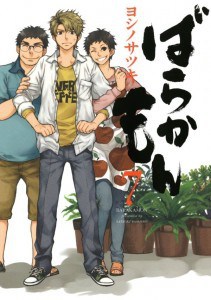 The contrast between city and rural life has been a source of entertainment since the time of Aesop’s fables. It remains a popular subject in manga and anime today, and joining the ranks of Silver Nina, Non Non Biyori, and Silver Spoon is Yen Press’ series Barakamon. Read on for my review of Volume 7! (For my reviews of previous volumes, click here.)
The contrast between city and rural life has been a source of entertainment since the time of Aesop’s fables. It remains a popular subject in manga and anime today, and joining the ranks of Silver Nina, Non Non Biyori, and Silver Spoon is Yen Press’ series Barakamon. Read on for my review of Volume 7! (For my reviews of previous volumes, click here.)
Back cover blurb
With the exhibition behind him, handsome young calligrapher Seishuu Handa returns safely from Tokyo. Between a full-moon night spent with the islanders, a grade-school recital, and a discussion of Hiroshi’s career plans, life is plenty hectic as autumn arrives at the island! The evening sun warms straight to the heart in Volume 7 of this super-popular hot ‘n’ hearty island comedy!
The Review
Now that Handa’s gotten things settled in Tokyo, it’s back to the village and Barakamon’s usual format of stand-alone chapters. Yoshino-sensei also reverts to standard formulas for several scenes. Act 53 has Handa at his most city-boy-in-the-country hapless/helpless as he settles back into his home. In Act 54, the instant Handa’s window shows up in the story, it’s pretty obvious glass will break by the end. And Act 55 is a series of four-panel comics capitalizing on Handa’s unfortunate attraction to cats.
However, the volume manages to branch out beyond the clueless sensei humor even as Handa humiliates himself time and again. When the kids practice their school play, it’s a given that they will cause grief for Handa, but the big surprise is Hiroshi’s mom. Stage mothers aren’t just limited to the city, and her particular passion for drama is an unexpected source of hilarity. The other person who gets a lot of attention in this volume is Hiroshi. He might not be a character out of his element, but as the villager who carries the label “ordinary” like it’s a curse, he suffers plenty of mortification in the name of comedy. By the end of the chapter, he winds up with a new hairstyle and new nickname that just gives the others more ammunition to tease him with.
Still, it’s not all silliness. Hiroshi’s concerns about his future career reflect the quandary many small-town young people face. Amid the rambunctiousness of the village’s version of Halloween is a touching portrait of the respect and affection the youngsters have for their elders. And as the elementary school students conclude their school recital, Handa once again wonders about Naru’s family circumstances.
Extras include a bonus four-page manga, translation notes, and pictures of a Barakamon limited-edition figure (which is sadly only available in Japan).
In Summary
I would have thought that Handa would have a clear picture of Naru’s family circumstances by now, but Yoshino-sensei only drops another tiny hint and sticks mainly to comic episodes. The Handa/village kids interactions are getting predictable, and Yoshino-sensei changes things up by giving some of the villagers a little more panel time. Hiroshi in particular winds up the butt of a lot of jokes, but his “ordinary” complex starts to get a bit stale by the end of the volume.
First published at The Fandom Post.





